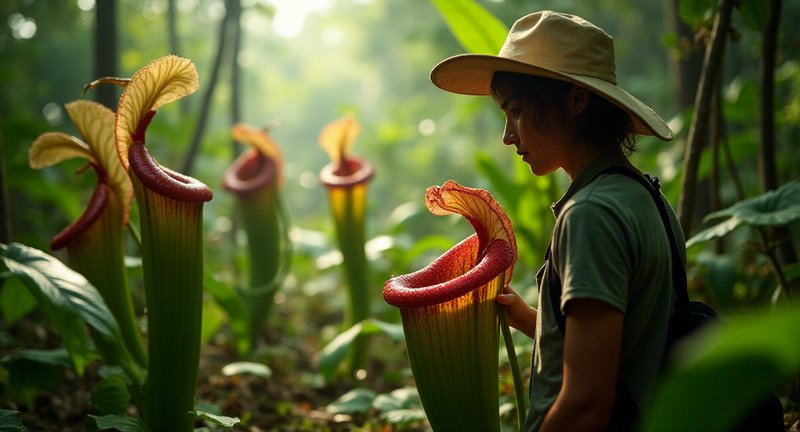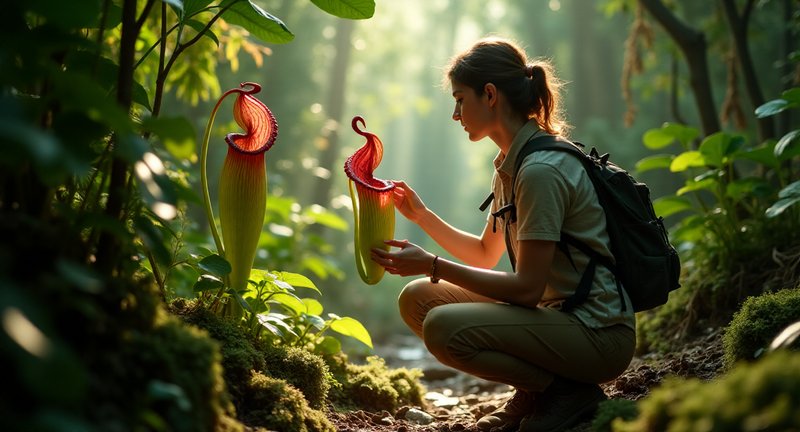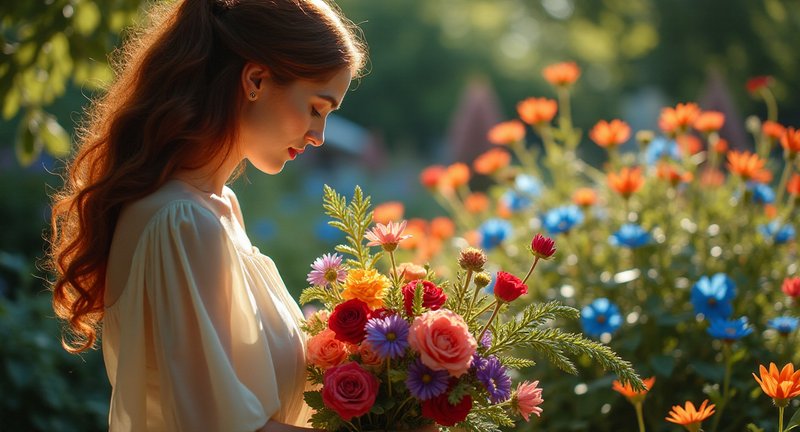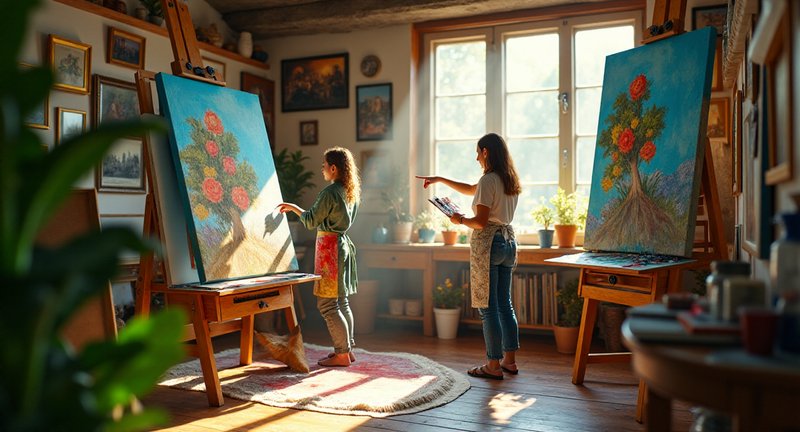The Essentials of Nepenthes Ventricosa
When dealing with cultivating unique plants, few can compare to the intriguing beauty of Nepenthes Ventricosa. As a passionate plant enthusiast, I’ve had the joy of nurturing this carnivorous wonder, and let me tell you, it’s an experience like no other. If you’re considering adding this gem to your collection, here are some essentials to keep in mind:
Growing Conditions:
- Light: Tropical pitcher plant thrives in bright, indirect sunlight. A well-lit windowsill or grow light can work wonders.
- Humidity: This plant loves a humid environment. Aim for 50-70% humidity to keep your plant happy.
- Temperature: It prefers temperatures between 20-30degC (68-86degF) during the day, with a slight drop at night.
Watering Tips:
- Use distilled or rainwater tap water can be too harsh for these delicate beauties.
- Keep the soil moist but not soggy; a balance is key to preventing root rot.
Feeding Your Climbing carnivorous plant:
- While it catches insects naturally, supplementing with insect protein can encourage growth. I occasionally toss in some dried bloodworms or crushed insects.
Potting and Soil:
- Use a well-draining mix, ideally a combination of sphagnum moss, orchid bark, and perlite. This ensures the roots breathe while retaining moisture.
In my experience, the charm of Highland nepenthes lies not just in its exotic look but also in the satisfaction of caring for a plant that embodies nature’s artistry. As you nurture this beauty, you’ll find joy in its evolving form, transforming your space into a mini jungle.

Embrace the journey with Nepenthes species, and soon you’ll understand why so many plant lovers are captivated by its allure.
The Beauty of Nepenthes Ventricosa
As I wandered through the lush landscapes of Southeast Asia, I was captivated by the enchanting allure of a particular carnivorous plant. Its elegant form, like a natural work of art, beckoned me closer, revealing a world of vibrant colors and intriguing shapes.
These remarkable plants possess unique, pitcher-like structures that are not only visually stunning but also serve a functional purpose. Their whimsical designs entice unsuspecting insects, drawing them into a hidden trap, much like a carefully laid out stage for nature’s performance.
Standing amidst these botanical wonders, I couldn’t help but admire their tenacity. They thrive in challenging environments, finding beauty in adversity. It’s a humbling reminder that even in the harshest conditions, life can flourish.

One of the most delightful aspects of these plants is their adaptability. Each specimen seems to have its personality, with variations in color, size, and shape. It’s as if they’re engaged in a friendly competition, showcasing their beauty to all who pass by.
If you ever get the chance to cultivate one, you’ll discover the joy of nurturing a creature that challenges conventional gardening wisdom. Watching it grow and evolve brings a sense of satisfaction, reminding me of the delicate balance between nature and nurture.
So, next time you’re looking for a conversation starter or a unique addition to your garden, consider inviting one of these beauties into your life. They’re not just plants; they’re fascinating companions that tell a story of resilience and wonder.
Introduction to Tropical Pitcher Plants
Tropical pitcher plants are nothing short of nature’s exquisite masterpieces. With their mesmerizing shapes and vibrant colors, these carnivorous wonders never fail to captivate me. Imagine a garden where every corner reveals a new design, an intricate sculpture created by Mother Nature herself.
Key Features of Tropical Pitcher Plants
-
Unique Trap Mechanism:
- Unlike your typical flora, these plants utilize a fascinating trap system. Their modified leaves form deep, pitcher-shaped vessels filled with a digestive liquid that entices and captures unsuspecting insects.
-
Vibrant Colors and Patterns:
- From lush greens to bold reds, the colors of these plants are a feast for the eyes. Many species sport intricate patterns, acting like nature’s own advertisements, luring prey into their sticky embrace.
-
Adaptability:
- Thriving in nutrient-poor environments, these plants have evolved to become efficient predators. Their ability to digest insects allows them to thrive where other plants may struggle.
-
Care Requirements:
- Caring for these beauties can be an adventure. They require:
- High humidity: Mimicking their tropical habitat is crucial.
- Bright, indirect light: Too much direct sunlight can scorch their delicate leaves.
- Specialized soil: A mix that drains well yet retains moisture is key.
- Caring for these beauties can be an adventure. They require:
In my own experience, nurturing a tropical pitcher plant is like fostering a tiny ecosystem. I remember the thrill of watching my first plant develop its pitchers, a slow but exhilarating process. It’s a reminder of nature’s wonders and the intricacies of life. If you ever find yourself captivated by these plants, you’re not alone; many enthusiasts are drawn into their mysterious world.
Understanding the Unique Features of Ventricosa
When I first stumbled upon this remarkable plant, I was instantly captivated by its enchanting allure. Its striking features and vibrant hues draw you in, like a siren’s call beckoning you to explore further.
The unique shape of its leaves is a wonder in itself. They transform into beautiful, tubular structures that not only catch the eye but also serve a practical purpose attracting unsuspecting insects with their sweet nectar. It’s a fascinating dance of nature, where beauty meets functionality in the most exquisite way.
One thing I find particularly intriguing is how this plant thrives in nutrient-poor environments. It seems to flourish where others falter, a testament to its resilience. There’s something inspiring about a creature that has adapted so well to its surroundings, reminding us that strength often lies in the most unexpected places.
In my experience, growing this plant can be both rewarding and challenging. It demands a specific balance of humidity, light, and temperature, which can feel like a delicate tango. But the moment you see it flourish, it feels like a personal victory an achievement worthy of celebration.
Perhaps what I appreciate most is its striking coloration. The deep greens and rich purples create a visual feast that transforms any space into a mini jungle. It’s as if each plant tells its own story, full of mystery and adventure, inviting you to lose yourself in its world.
Embracing this unique botanical marvel has not only enhanced my gardening journey but also deepened my connection to the wild. If you ever consider adding one to your collection, prepare for an adventure that promises to surprise and delight you at every turn.
Ideal Growing Conditions for Tropical Pitcher Plants
Creating a paradise for tropical pitcher plants is like crafting a miniature rainforest right in your living space. Having cultivated these fascinating plants myself, I’ve discovered that their ideal growing conditions mimic the humid and warm climates of their natural habitats.
First off, let’s talk temperature. These tropical wonders thrive in warmth, flourishing in temperatures between 70degF and 85degF. If you can provide a cozy spot that hugs these temperatures, you’re well on your way to ensuring their happiness. Remember, though, they do appreciate a bit of a nighttime chill, so don’t be afraid to let it drop to around 60degF for a few hours.
Humidity is another crucial factor. These plants adore moisture-rich air, often preferring levels above 50%. I’ve found that a simple humidity tray filled with water and pebbles does wonders. Alternatively, you might consider misting them regularly to replicate the damp environment they crave. Just be careful not to drown them; a gentle touch goes a long way.
Light also plays a starring role in the growth saga of these beautiful plants. Bright, indirect light is the sweet spot. They enjoy basking in bright surroundings but can be a bit temperamental when exposed to direct sunlight. I often rotate my plants to ensure they soak up that beautiful light from all angles.
Also, the right soil mix can make or break their growth journey. A well-draining blend rich in sphagnum moss and perlite ensures their roots stay healthy and happy.
In essence, nurturing tropical pitcher plants is about creating a little slice of paradise that they can truly thrive in.
Selecting the Right Soil for Your Pitcher Plant
Selecting the right soil for your pitcher plant is a bit like choosing the perfect dress for a special occasion. You want something that fits just right and enhances the natural beauty of your green companion.
In my experience, a well-draining medium is crucial. These fascinating plants thrive in conditions that mimic their native habitats think bogs and swamps, where water drains freely yet retains a touch of moisture.
I usually concoct a blend that includes sphagnum moss, perlite, and orchid bark. This unique combination creates a fluffy, airy environment, ensuring that the roots can breathe and flourish without drowning in a soupy mess.
It’s also essential to keep an eye on the pH level. Pitcher plants prefer a slightly acidic mix, so I often add a dash of pine bark to my concoction. It’s like giving the soil a little pep talk, urging it to create the perfect home for my beloved plants.
When repotting, I always take care to gently tease the roots apart. This process can be a little daunting, but trust me, it’s worth it. Once they settle into their new soil, it’s like watching them breathe a sigh of relief.
Also, remember that patience is key. The right soil will nurture your pitcher plant, but it may take some time to see those gorgeous traps unfurl. So, sit back, enjoy the process, and let your plant work its magic.
Watering Techniques for Optimal Growth
Considering fostering the ideal environment for healthy growth, watering techniques are paramount. Over the years, I’ve experimented with various methods, and believe me, finding the right balance is key to thriving plants. If you’re anything like me, you want to avoid the dreaded “too much or too little” scenario that can leave your plants gasping for life.
The foundation of proper watering is rooted in understanding the unique needs of each plant. While some thrive in moist soil, others prefer a more controlled dry-wet cycle. Here are a few tips to help you navigate the journey:
-
The Humidity Trick: Some plants adore high humidity. Consider using a tray of water with pebbles beneath your pot. This creates a subtle microclimate that helps regulate moisture around the plant without drowning its roots.
-
Slow and Steady Wins the Race: Ever heard the advice to water slowly? It’s a game-changer. I’ve found that watering gradually, rather than flooding the soil all at once, ensures that the roots absorb water more efficiently. Try this next time and you’ll notice the difference.
-
Watch the Leaves: Believe it or not, the leaves can be your guide. When plants start to look a little limp, it’s a signal they may need a drink. But don’t wait until they’re drooping every time it’s always better to be a step ahead!
-
Distilled Water Delight: Some plants don’t get along with tap water due to chemicals like chlorine. Distilled or rainwater is often a better option. I’ve seen how switching to these alternatives can make a world of difference in overall health.
Remember, each plant species has its quirks. Mastering their hydration routine might take some practice, but trust me, it’s worth the effort when you see them flourish under your care.
The Importance of Humidity for Tropical Plants
Humidity is like the lifeblood for tropical plants. Without it, their leaves grow brittle, losing the vibrancy they should naturally display. I’ve watched plants wither in dry conditions, even with perfect sunlight and rich soil.
Think of the rainforest, where the air clings to your skin plants from these environments expect that embrace. The moment you bring them home, they’re no longer in that perfect world, so we must recreate it. Humidity isn’t just a luxury for these plants; it’s a requirement.
Many people think watering more will solve the issue, but that’s a misstep. Over-watering only leaves the roots soggy, while the leaves still thirst for moisture. Instead, a humidifier, misting routine, or even a simple tray of water can perform wonders.
It’s fascinating how certain plants practically unfold in a humid environment. They’re delicate, yet strong-willed. The humidity makes them breathe easier, enhances their colors, and allows them to stretch towards the sky.
From personal experience, you’ll notice that plants with specialized needs those that grow in mossy, high-altitude regions demand higher humidity to thrive. It’s almost as if they want to feel the breath of the jungle around them.
But don’t overdo it. If humidity climbs too high without ventilation, mold or rot could settle in, making your plant’s worst fears come true. It’s all about balance.
Light Requirements for Healthy Growth
With regard to ensuring healthy growth for your carnivorous plants, light is an essential ingredient. Now, let me tell you about the light requirements for Nepenthes Ventricosa. If you want these plants to thrive, forget low-light corners. This beauty needs to bask in bright, indirect light like it’s on a tropical vacation, but with sunscreen. Direct sunlight can actually scorch its delicate leaves, leaving you with a crispy plant, not the lush green foliage you crave.
Here’s what I’ve found works best:
-
Bright, Indirect Light: A good rule of thumb is around 8 to 12 hours of indirect sunlight daily. Position your plant near an east-facing window for soft morning rays, but avoid harsh afternoon sun.
-
Supplement with Grow Lights: If natural light isn’t cutting it, you can supplement with grow lights. LEDs work wonders without overheating the plant. Aim for a color spectrum of 4000-6000K to mimic daylight conditions.
-
Avoid Low-Light Situations: While Ventricosa nepenthes can tolerate some shade, too much will stifle its growth. The pitchers, those whimsical insect-trapping structures, might not even form without enough light. And what’s a Nepenthes without its pitchers? Just a plant, if you ask me.
-
Watch for Leaf Color: One trick I’ve learned is to keep an eye on leaf color. If your plant’s leaves turn yellow, that’s a signal it’s getting too much light. If they become pale or the plant becomes leggy, it’s time to give it more light.
Remember, Highland nepenthes is native to highland environments where sunlight is filtered through a canopy of trees. So, recreate that natural habitat as closely as possible, and your plant will reward you with stunning pitchers.
Fertilizing Your Pitcher Plant: Best Practices
Fertilizing your pitcher plant is like giving a gourmet meal to a guest with very specific tastes. It can be tempting to go all-in with nutrients, but with carnivorous plants, less is often more. Based on my own experience, here’s what I’ve found to work best.
When to Fertilize
Pitcher plants don’t need heavy fertilizing since they get most of their nutrients from insects. However, in captivity, they might benefit from a light feeding now and then especially if they’re not catching as many bugs as they would in the wild. I like to give my plant a little nutrient boost during its active growing season, which is spring through early fall. It helps it maintain vibrant growth without overwhelming it.
Best Fertilizers
Forget about conventional houseplant fertilizers your plant won’t appreciate it. Instead, go for diluted orchid or carnivorous plant fertilizers. A 1/4 strength solution is usually enough. It’s like serving a fine-tuned cocktail rather than a heavy feast. You can also try fish emulsion, but keep it light nobody likes a pungent dinner.
How to Apply
There are two ways I typically apply fertilizer:
- Directly into the pitchers: I use a dropper to place a few drops of the diluted solution right into the pitchers. It mimics the natural way these plants absorb nutrients from their prey.
- Foliar feeding: Spraying the fertilizer on the leaves can also work, but make sure it’s not too strong. A gentle mist every few weeks will do the trick.
Keep in mind, too much love (or fertilizer) can be a bad thing. Always err on the side of caution your plant will thank you by showing off its healthy, vibrant colors.
Common Pests and Diseases: Prevention and Treatment
When diving into the world of carnivorous plants, you’ll encounter a plethora of pests and diseases that threaten their unique beauty. Trust me, after my years of nurturing these green wonders, I’ve learned a thing or two about prevention and treatment. Here’s what I’ve found most effective.
Common Pests:
- Aphids: These tiny invaders can sap your plant’s energy. Keep an eye out for sticky residue and distorted leaves.
- Spider Mites: Their presence is often betrayed by fine webbing. If you see it, act quickly!
- Mealybugs: These fuzzy pests can hide in leaf joints and crevices. They love to feast on sap, leaving your plants vulnerable.
- Fungus Gnats: These little flies can be a nuisance, but their larvae feast on roots. A well-draining soil can help keep them at bay.
Common Diseases:
- Root Rot: Often caused by overwatering, this silent killer can be devastating. Make sure your pots have adequate drainage.
- Fungal Infections: Look out for spots or discoloration on leaves. Remove infected leaves immediately to prevent spread.
- Powdery Mildew: This white, powdery coating is unsightly and can weaken your plant. Ensure good airflow around your plants.
Prevention Strategies:
- Regularly inspect your plants for any signs of trouble.
- Maintain a clean growing environment sanitize your tools and pots.
- Use insecticidal soap or neem oil to treat infestations organically.
Treatment Tips:
- For aphids and mealybugs, a strong blast of water can dislodge them.
- If root rot occurs, repot the plant in fresh, dry soil and avoid overwatering.
- Implement companion planting with marigolds, which can deter pests naturally.
Remember, a little vigilance goes a long way in preserving the delicate balance of your carnivorous garden.
A Thorough Understanding of Nepenthes Ventricosa
As I ventured into the mesmerizing world of carnivorous plants, I stumbled upon a particularly captivating species that quickly became a favorite of mine. This plant, known for its unique, goblet-like traps, is a true marvel of nature. Allow me to share a thorough understanding of its allure.
Key Features:
- Shape-Shifting Traps: Its elongated, tube-like structures are designed to attract and ensnare unsuspecting insects. The vibrant colors and enticing nectar create an irresistible invitation.
- Cultural Adaptability: Thriving in a range of environments, from tropical highlands to lowlands, this species showcases remarkable versatility. It’s a resilient companion for those seeking to cultivate exotic greenery in their homes.
-
Care Requirements: If you decide to welcome one into your life, here are some tips:
- Lighting: Bright, indirect sunlight is ideal. Too much direct light can scorch its delicate leaves.
- Watering: Use distilled or rainwater to keep the soil consistently moist, avoiding tap water which can harm this delicate creature.
- Feeding: While it can catch its own meals, offering a few dried insects can help it thrive, especially during the growing season.
My Personal Journey: When I first introduced this stunning plant into my collection, I was mesmerized by its enchanting beauty. Watching it develop and adapt to my care routine was an incredibly rewarding experience. It became a conversation starter among my friends and a focal point in my living space, sparking curiosity and admiration.

If you’re considering adding this extraordinary species to your botanical family, be prepared for the joy of nurturing a true marvel of the natural world.
Pruning and Maintenance Tips
In the context of cultivating these captivating carnivorous plants, pruning and maintenance become essential rituals that transform the mundane into the extraordinary. From my experience, the art of care lies not only in the hands but also in the heart.
Pruning Tips:
- Remove Dead Leaves: Snip away any browning foliage to maintain the plant’s health and aesthetics. It’s like giving a haircut to a friend it allows them to shine!
- Cutting Flower Stalks: If your plant sends up flower stalks, consider trimming them to redirect energy back into the leaves, ensuring they remain lush and vibrant.
- Timing Matters: Aim to prune during the growing season, typically spring and summer, to promote robust regrowth.
Maintenance Guidelines:
- Water Wisely: These plants thrive in moist environments. Use distilled or rainwater tap water can be detrimental to their well-being. Think of it as providing your plant with gourmet hydration.
- Humidity is Key: Aim for a humidity level of around 50-70%. Misting or using a humidity tray can create a tropical paradise right in your home.
- Light Requirements: Place your plant in bright, indirect sunlight. Too much direct sun can scorch their delicate leaves. Consider it like choosing the right outfit for a sunny day comfort is crucial!
Feeding Essentials:
- Insect Snack Time: If you have the luxury of live insects, feed them occasionally. These plants are natural hunters and will appreciate the treat. If not, a diluted orchid fertilizer can do the trick, offering them a taste of something special.
Remember, caring for these wonders is a journey, not a destination. Each cut and every drop of water is a step toward nurturing your little green miracle.
Repotting Your Tropical Pitcher Plant
With respect to repotting your tropical pitcher plant, it feels like embarking on an enchanting journey into the world of lush greenery. I remember the first time I tackled this task; it was as if I was preparing a tiny botanical feast. Here’s how I approach the delicate art of repotting these captivating carnivores.
Preparation is Key
Before diving into the soil, gather your tools and supplies:
- A fresh pot, preferably a couple of inches wider than the old one
- High-quality carnivorous plant soil mix
- Clean water (preferably distilled)
- A small shovel or spoon
- A pair of scissors (for any unruly roots)
The Repotting Process
- Choose the Right Time: The best time to repot is during the growing season, ideally in spring. This helps your plant acclimate faster.
- Remove the Plant: Gently squeeze the pot to loosen the roots, and carefully lift your plant out. Be cautious; you don’t want to disturb the delicate tendrils.
- Inspect the Roots: Look for any signs of rot or damage. Trim away any dead or mushy roots with scissors.
- New Home: Place your plant in the center of the new pot and add fresh soil around the roots. Ensure that the top of the root ball is level with the soil surface.
- Watering: After repotting, water thoroughly until it drains from the bottom. This ensures the roots settle in nicely.
Watching your tropical pitcher plant thrive after a repotting session is immensely satisfying. Trust me, your plant will thank you by growing more vibrant and producing those stunning pitchers that draw us in!
Propagation Methods for Ventricosa
Propagation of this fascinating carnivorous plant can be an exhilarating journey. From my own explorations, I’ve discovered a few captivating methods that can breathe life into your collection.
One of my favorite techniques is through cuttings. Imagine snipping off a healthy vine and coaxing it to sprout roots in water. It feels like wielding a magic wand as you witness new life emerging from the tiny node.
Another enchanting method is seed propagation. Collecting seeds can feel like gathering tiny treasures. Once sown, they require a warm, humid environment, and soon you’ll find yourself eagerly peeking under the soil to see if anything is sprouting.
For those adventurous souls, division offers a thrilling challenge. Carefully separating the plant’s rosettes can be nerve-wracking, but it’s rewarding to see each section flourish. Just make sure to give each division its own cozy spot to thrive.
Then, there’s tissue culture a scientific dance that requires patience and precision. While it might seem daunting, creating a sterile environment can lead to an abundance of plantlets. Just think, with a little effort, you could cultivate an entire army of these stunning specimens.
Whichever method you choose, remember that each step is a part of a grand adventure. With a sprinkle of enthusiasm and a dash of care, you’ll find that propagation isn’t just about growing plants; it’s about nurturing your passion.
Information Hub
What is Tropical pitcher plant?
N. ventricosa is a tropical carnivorous plant native to Southeast Asia, particularly found in regions like the Philippines and Malaysia. It belongs to the Nepenthaceae family and is known for its unique, pitcher-shaped leaves that trap insects for nutrients. The plant thrives in nutrient-poor, acidic soils, often growing in montane habitats. Its striking appearance, with vibrant colors and varied shapes, makes it popular among plant enthusiasts and collectors. Asian carnivorous plant is also recognized for its ability to adapt to various growing conditions, making it a fascinating species in the Nepenthes genus.
What temperature is good for Montane nepenthes species?
Nepenthes species prefers a temperature range between 20degC to 30degC (68degF to 86degF) during the day and slightly cooler at night, ideally around 15degC to 20degC (59degF to 68degF). These temperature conditions simulate its natural montane habitat, promoting healthy growth and pitcher development. It’s essential to avoid temperature extremes, as prolonged exposure to temperatures below 10degC (50degF) can harm the plant. If you’re growing Tropical pitcher plant indoors, ensure proper ventilation and maintain humidity levels to create a suitable environment for optimal growth.
Do Nepenthes like sun or shade?
N. ventricosa enjoys bright, indirect sunlight but can also tolerate partial shade. Ideally, it should receive around 6 to 8 hours of filtered sunlight daily. Too much direct sunlight can scorch the leaves, while insufficient light can hinder its growth and pitcher formation. If grown indoors, placing the plant near a bright window with filtered light or using grow lights can help replicate its natural conditions. Observing the plant’s response to light is crucial; yellowing leaves may indicate too much sun, while leggy growth suggests it needs more light.
How to care for Asian carnivorous plant?
Caring for Montane nepenthes species involves providing the right balance of light, temperature, humidity, and water. Ensure the plant is in a well-draining, acidic medium, such as sphagnum moss or a peat-perlite mix. Maintain humidity levels above 50% for optimal growth, and water the plant regularly with distilled or rainwater. It’s essential to feed it occasionally with insects or a diluted fertilizer during the growing season to enhance pitcher development. Regular pruning of dead leaves and monitoring for pests will also help keep the plant healthy and thriving.
Do Nepenthes like to be misted?
Yes, Nepenthes species benefits from misting, particularly in low-humidity environments. Misting the leaves increases humidity levels around the plant, which is crucial for its health and well-being. This practice can also help prevent the leaves from drying out and promote pitcher formation. However, it’s essential to ensure the water used is distilled or rainwater, as tap water can harm the plant. Regular misting, especially during dry seasons or in heated indoor conditions, can enhance the overall growth and vitality of Tropical pitcher plant.
Can you water Nepenthes with tap water?
It is not recommended to water N. ventricosa with tap water, as it often contains minerals, chlorine, and other chemicals that can harm the plant. Instead, using distilled water, rainwater, or reverse osmosis water is ideal, as these options provide the pure and acidic conditions Nepenthes prefer. Regularly using inappropriate water can lead to mineral buildup in the soil, potentially stunting growth or causing leaf burn. Monitoring the water quality and ensuring it meets the plant’s needs is essential for its overall health.
How can you tell if Nepenthes is male or female?
Determining the sex of Asian carnivorous plant can be challenging, as it usually requires close observation during the flowering stage. Male plants typically produce pollen in long, slender inflorescences, while female plants develop larger flowers with a more pronounced ovary. In some cases, you may notice differences in the growth patterns, as female plants might grow more robustly to support seed production. However, many growers find it easier to identify the sex through flowering, which often occurs when the plant is mature and adequately cared for.
Should you bottom water Nepenthes?
Bottom watering is a beneficial technique for Montane nepenthes species, allowing the plant to absorb water through the drainage holes at the bottom of the pot. This method helps prevent overwatering and reduces the risk of root rot, which can occur with traditional top watering. Ensure the potting medium is moist but not soggy, and only bottom water when the top layer of the medium feels dry. By allowing the plant to draw up the water it needs, you create a more balanced moisture level that supports healthy growth.
Do Nepenthes need to hang?
While Nepenthes species does not strictly need to hang, hanging them can provide optimal conditions for growth and pitcher development. Many species of Nepenthes are epiphytic and often grow in trees, so hanging pots can mimic their natural environment. This setup allows for better airflow and access to light, which are vital for their health. Additionally, hanging can help prevent rot by ensuring the plant drains well. However, if you choose to keep it in a traditional pot, ensure it has enough light and humidity for healthy growth.
What is the easiest Nepenthes to grow?
Among the various species, Nepenthes ventrata is often regarded as the easiest Nepenthes to grow, especially for beginners. It is a hybrid of N. ventricosa and N. alata, making it more resilient and adaptable to various growing conditions. Venturing requires moderate light, humidity, and temperatures, making it forgiving for novice gardeners. It produces beautiful, colorful pitchers and is relatively low-maintenance, thriving in both indoor and outdoor environments. For those new to growing Nepenthes, starting with ventrata can build confidence and experience before exploring more challenging species.











Wow, this section on pests and diseases really hits home! As someone who has had my fair share of battles with aphids and spider mites, I can’t stress enough how important vigilance is. I’ve learned to check my plants regularly, and I even keep a little spray bottle of insecticidal soap handy for emergencies. It’s amazing how quickly pests can wreak havoc, but your point about companion planting with marigolds is a game changer! I’ve recently added some to my garden, and not only do they look pretty, but they also seem to be keeping those pesky critters at bay. Your advice on dealing with root rot is also so valuable. I remember losing a beautiful plant to that silent killer, and I now ensure my pots have excellent drainage. Great job laying out these tips it’s reassuring to know I’m not alone in this carnivorous plant journey! Keep the wisdom coming!
I absolutely love your analogy about fertilizing pitcher plants being like a gourmet meal! It’s so true carnivorous plants have such specific needs, and I’ve learned the hard way that less really is more. During my own journey, I found that using a diluted orchid fertilizer has worked wonders. I typically feed mine in spring when they’re most active, but I make sure to hold back a bit and watch for those telltale signs that they might be overwhelmed. Your advice about applying fertilizer directly into the pitchers is spot on! I’ve seen a noticeable difference since I started doing that. Also, the tips about fish emulsion being pungent are so relatable I remember the first time I tried it, and it felt like I’d invited a fish market into my home! Overall, your insights are not only practical but also entertaining. Thank you for sharing such valuable tips I can’t wait to put them into action this growing season! Let’s all give our little green friends the best care pos
Your insights on lighting for Nepenthes Ventricosa are spot on! I love how you described their need for bright, indirect light it’s like they’re on a tropical vacation! I learned the hard way about the dangers of too much direct sunlight when one of mine got scorched. It was like a sad little crispy pancake! Your advice about using grow lights is fantastic; I’m planning to set up a little grow station soon. I appreciate the detail on light duration, too; it’s fascinating how much they thrive under just the right conditions. And yes, the colors of the leaves are definitely a telltale sign! I’ve also noticed how my Nepenthes seems to ‘show off’ its pitchers when conditions are just right. Thanks for emphasizing how closely we need to mimic their natural habitats; it’s truly rewarding when they flourish! Keep up the great work; I look forward to more tips!
I really appreciate your take on the importance of humidity for tropical plants! It’s true; I’ve witnessed the sad fate of my favorite plants when I didn’t provide enough moisture. It’s like a dance between plants and their environment, right? Your idea of recreating a rainforest vibe is so imaginative! I often mist my plants, but I’ve never considered a humidifier what a game changer that could be! It’s like giving them a tropical vacation at home. I laughed at your description of how they practically unfold in humidity; I’ve seen my plants perk up right before my eyes! Also, your caution about overdoing it is a good reminder. I’ve had a run-in with mold myself, and it’s no fun. Balance really is the name of the game! Keep sharing your wisdom; it’s refreshing!
I completely resonate with your experience regarding watering techniques! It’s so easy to fall into the trap of overwatering or underwatering, isn’t it? I’ve made those mistakes myself, and I can’t stress enough how important it is to know your plant’s preferences. Your tip about using a tray with pebbles is brilliant! I actually have a few plants that love humidity, and this has saved me many times. It’s like creating a little spa for them! Also, I loved your insight about watching the leaves for signs of thirst. It’s almost like they have their own way of communicating with us. I once neglected my peace lily for a couple of days, and the droop was almost a dramatic cry for help! Thanks for sharing these practical tips; they really do make a difference in nurturing our green friends!
Absolutely love the analogy about selecting the right soil! It really does feel like dressing up your plant for success. I also mix sphagnum moss and perlite for my pitcher plants, and it’s worked wonders. Your tip about adding pine bark for that acidic touch is golden! I wish I had known that earlier; I struggled with a few plants that just wouldn’t thrive. Repotting can be nerve-wracking, but it’s like a fresh start for them. I usually play some music while doing it to lighten the mood it’s become a little ritual for me. Thanks for sharing such helpful insights!
Creating a mini rainforest at home sounds like an incredible adventure! I’ve been nurturing tropical pitcher plants for a while now, and I can wholeheartedly agree that providing them with the right conditions is crucial. It’s like setting up a cozy home for them, isn’t it? I’ve learned the hard way about the importance of humidity; I had a few plants that just didn’t thrive until I invested in a good humidity tray. And I completely echo your thoughts about light; rotating my plants not only keeps them happy but also adds a dynamic vibe to my space. Sometimes, I even talk to them while I water and mist them definitely makes gardening feel even more rewarding!
I totally relate to that feeling of being enchanted by these unique plants! When I first spotted a pitcher plant, I was also drawn in by its vibrant colors and quirky shape. It’s fascinating how these plants not only look amazing but also have that clever way of attracting insects. I’ve found them to be a great conversation starter among friends who visit my garden. Each time I see my pitcher plant thriving, it reminds me of nature’s magic!
I couldn’t agree more with your thoughts on tropical pitcher plants! They truly are nature’s little masterpieces, and the way they capture insects is nothing short of fascinating. I still remember the first time I saw a fully developed pitcher on my plant it felt like a mini miracle! Your points on their vibrant colors and adaptability really highlight their charm. It’s inspiring to see how these plants thrive in nutrient-poor environments, reminding us of the beauty in resilience. I’ve started experimenting with different soil mixes, and I can confirm that the right balance makes all the difference! If you’re looking for a conversation starter, these plants are perfect; they always draw questions and curiosity. Plus, their beauty transforms any space into a lively conversation piece!
Your description of the carnivorous plant world is so vivid! It’s like stepping into a botanical wonderland. I totally resonate with the idea that each plant has its own personality. I once had a Nepenthes that seemed to get more colorful with each season. It’s truly a unique experience watching them grow and adapt. Keep sharing your amazing plant stories!
I absolutely adore Nepenthes Ventricosa! Your passion shines through in this post, and I completely agree with your insights about their care. I’ve found that adjusting the humidity can really make a difference. When I first brought mine home, I struggled to maintain the right moisture level, but using a small humidifier changed the game! It’s amazing how these plants can thrive in such challenging conditions. The way they develop those gorgeous, intricate pitchers is like watching a nature documentary unfold right in your living room! Plus, who doesn’t love having a plant that catches its own food? It’s like having a pet that doesn’t need to be walked! If you haven’t tried feeding them with crushed insects yet, I highly recommend it it’s super satisfying to see them respond.